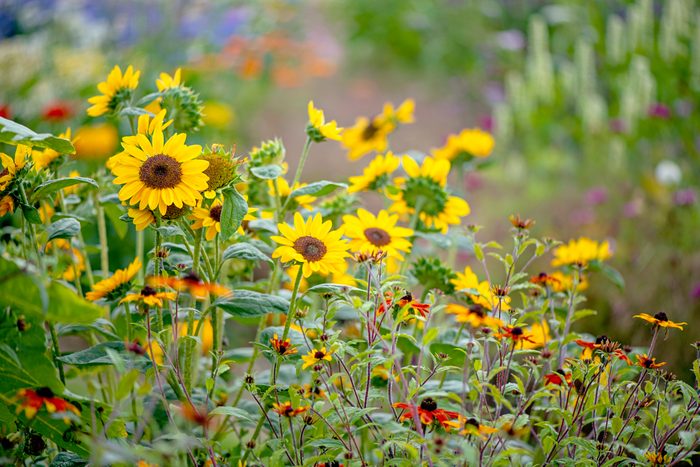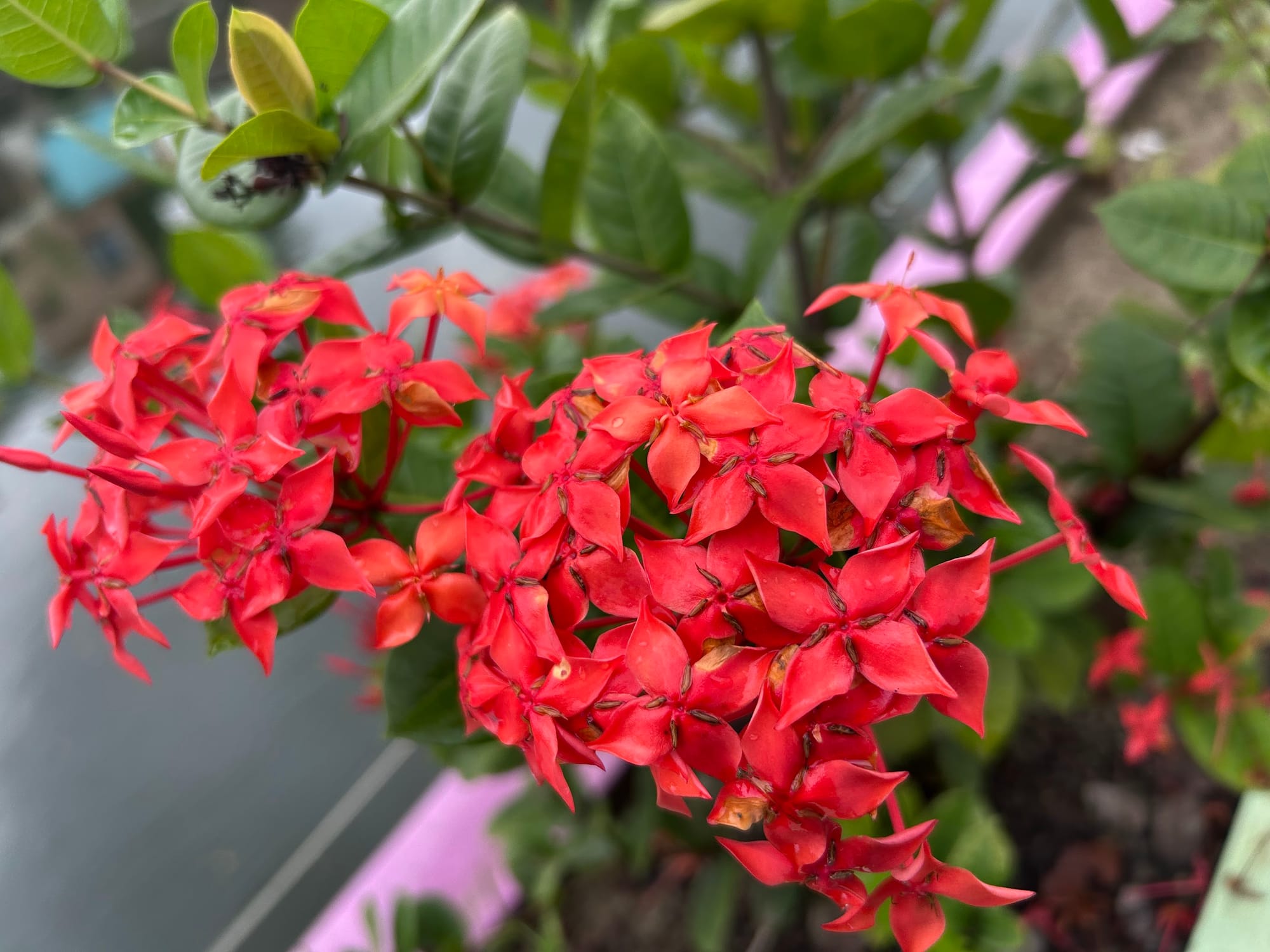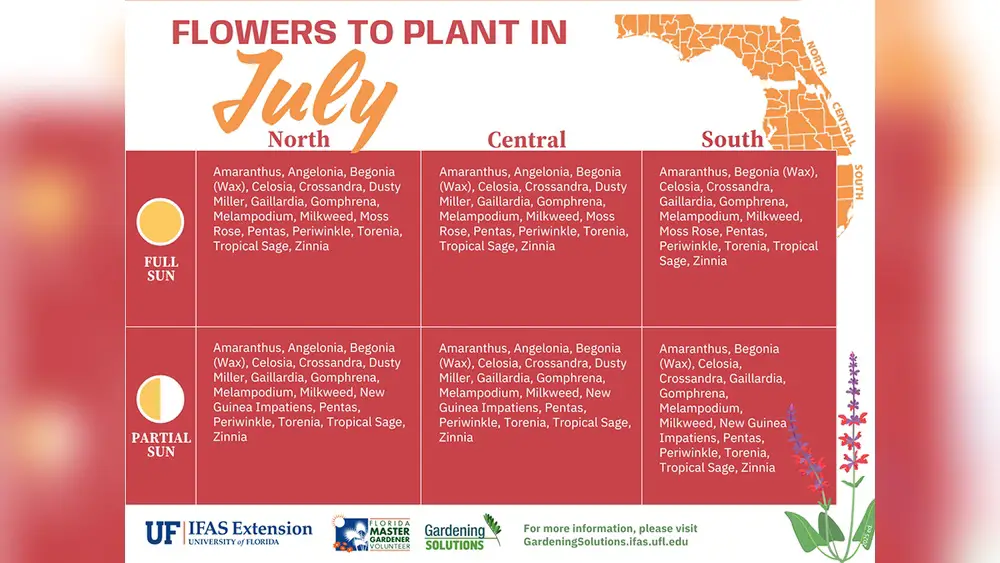Are you ready to transform your Florida garden into a colorful paradise? Choosing the best flowers to plant is key, but knowing how much sunlight they need can make all the difference.
Whether you have a sunny spot or a shady corner, understanding sunlight requirements helps your flowers thrive and bloom beautifully. Keep reading to discover which flowers will brighten your garden and exactly how much sun they crave—so you can enjoy vibrant blooms all year long.
Flower Choices For Florida Gardens
Choosing the right flowers for Florida gardens can brighten your outdoor space. The state’s warm climate and long sunny days allow many beautiful flowers to thrive. Selecting plants that suit Florida’s weather and sunlight needs is key to a healthy garden. Below are some great flower options for various garden styles and seasons.
Tropical Favorites
Tropical flowers bring vibrant colors and lush looks. Hibiscus is a popular choice with large, bright blooms. Plumeria offers sweet fragrance and beautiful petals. Bird of Paradise stands out with unique orange and blue flowers. These plants love full sun but need some afternoon shade in hot spots. They thrive in well-drained soil and regular watering.
Native Wildflowers
Native wildflowers are easy to grow and support local wildlife. Coreopsis, also called tickseed, produces sunny yellow flowers. Blanket flower has red and yellow petals, perfect for sunny spots. Milkweed is vital for butterflies and adds charm to gardens. These flowers need full sun and can tolerate dry conditions once established. They help keep the garden natural and lively.
Seasonal Blooms
Seasonal flowers add variety and color throughout the year. Marigolds bloom in warm months and resist pests well. Pansies bring cool-season color with their bright petals. Zinnias grow fast and come in many shades. These flowers prefer full sun and regular watering. Changing seasonal flowers keeps your garden fresh and attractive year-round.

Credit: www.familyhandyman.com
Sunlight Needs Explained
Sunlight is a key factor for growing flowers in Florida. Each flower has a specific need for sunlight. Understanding these needs helps you choose the right plants. This ensures healthy growth and vibrant blooms. Let’s explore the different sunlight levels plants require.
Full Sun Plants
Full sun means at least six hours of direct sunlight each day. Many Florida flowers thrive in this bright light. Examples include marigolds, zinnias, and sunflowers. These plants enjoy hot and sunny spots. They produce strong stems and bright colors under full sun.
Partial Shade Options
Partial shade means the plant gets about three to six hours of sunlight. Some sunlight filters through trees or buildings. Flowers like impatiens, begonias, and coleus grow well here. These plants need some sun to bloom but prefer cooler, shaded parts.
Shade-loving Flowers
Shade-loving flowers need less than three hours of direct sunlight. They grow best in shady areas or under trees. Ferns, caladiums, and hostas are good examples. These plants have delicate leaves and bright colors that show in low light.
Top Flowers For Full Sun
Florida’s sunny climate suits many bright, bold flowers. Full sun means at least six hours of direct sunlight daily. These flowers thrive in hot, bright places. They add color and life to gardens and landscapes. Choose flowers that handle strong sun and heat well. Here are some top picks for full sun in Florida.
Marigolds
Marigolds are easy to grow and very bright. They bloom in orange, yellow, and red shades. These flowers resist heat and pests. Marigolds need full sun to bloom well. Plant them in well-drained soil for best results. They also attract pollinators like bees and butterflies.
Zinnias
Zinnias bring vibrant colors like pink, red, and white. They grow fast and bloom all summer. These flowers love full sun and dry soil. Zinnias need regular watering but do not like soggy ground. They are perfect for borders and flower beds.
Sunflowers
Sunflowers are tall and bright, with large yellow petals. They need full sun to grow tall and strong. Sunflowers prefer well-drained soil and good air circulation. These flowers attract birds and add a cheerful look. They also make great cut flowers for bouquets.
Best Plants For Partial Shade
Partial shade areas in Florida gardens need plants that thrive without full sun. These spots get filtered sunlight or shade for most of the day. Choosing the right plants helps keep your garden colorful and healthy. Some flowers love this gentle light and will bloom beautifully.
Impatiens
Impatiens are perfect for spots with little direct sun. They bloom in many bright colors like pink, red, and white. These flowers stay fresh even in humid Florida weather. Water them often to keep the soil moist but not soggy. Impatiens brighten shady corners quickly.
Begonias
Begonias flourish in partial shade and warm temperatures. Their leaves come in many shapes and colors, adding texture to gardens. They also produce lovely flowers that last long. Begonias prefer well-drained soil and regular watering. They suit hanging baskets or garden beds alike.
Coleus
Coleus plants bring vivid leaf colors to shaded areas. Their leaves can be red, purple, green, or yellow. They grow well with indirect sunlight and need moderate watering. Coleus is easy to care for and adds style to shady spots. They work well as ground cover or in pots.
Ideal Flowers For Shady Spots
Shady spots in Florida gardens can be tricky for many flowers. Most plants need sunlight to grow well. Yet, some flowers thrive with less sun. These flowers bring life and color to darker corners. Choosing the right plants helps your garden stay bright and healthy. Below are some ideal flowers for shady spots.
Ferns
Ferns do very well in shade. They like moist, cool places with indirect light. Ferns add soft green texture to shady areas. They need regular watering to stay lush. Many fern types suit Florida’s warm climate. They also help keep garden soil healthy.
Caladiums
Caladiums are famous for their colorful leaves. They grow best in partial to full shade. These plants brighten shady spots with red, pink, and white patterns. Caladiums prefer warm, humid conditions. Water them often but avoid waterlogging. They make any shady garden stand out.
Hostas
Hostas thrive in shady gardens and need little sun. Their large leaves come in many shades of green. Some have white or yellow edges. Hostas need regular watering and well-drained soil. They are perfect for low-light spots under trees or porches. Hostas also attract butterflies and hummingbirds.
Soil And Water Tips
Choosing the right soil and watering properly are key for growing flowers in Florida. The soil needs to hold enough water but also drain well. Good watering helps plants grow strong and bloom bright. Below are simple tips to prepare soil, water your flowers, and use mulch to protect them.
Soil Preparation
Florida soil is often sandy and drains quickly. Mix organic matter like compost to add nutrients. This helps soil keep water longer. Test soil pH to keep it near 6.0 to 7.0 for most flowers. Loosen the soil well before planting for better root growth. Healthy soil means healthy flowers.
Watering Guidelines
Water flowers deeply but not too often. Early morning watering reduces water loss from heat. Check soil moisture by feeling it; water if dry. Avoid overwatering to prevent root rot. Use drip irrigation or soaker hoses for steady water. Proper watering keeps flowers fresh and growing.
Mulching Benefits
Mulch keeps soil moist and cool in hot Florida sun. It reduces weeds that compete for water and nutrients. Use organic mulch like bark or pine needles. Spread mulch about 2-3 inches thick around plants. Mulching saves water and helps flowers thrive.
Pest And Disease Control
Growing flowers in Florida requires attention to pests and diseases. These problems can harm your plants and reduce their beauty. Knowing how to control these issues helps keep your garden healthy and vibrant. Effective pest and disease control means less damage and more blooms.
Common Issues
Aphids and spider mites often attack Florida flowers. They suck plant juices, causing leaves to yellow. Fungal diseases like powdery mildew and rust also appear. These diseases create spots and weaken plants. Whiteflies and caterpillars are other frequent pests. They chew leaves and flowers, damaging the plant’s growth.
Natural Remedies
Soap spray can remove aphids and mites safely. Neem oil works well against many pests and fungi. Introducing ladybugs helps control aphid populations naturally. Garlic spray repels many insects without harming plants. Baking soda mixed with water can reduce fungal growth. These remedies protect flowers without harsh chemicals.
Preventative Measures
Choose disease-resistant flower varieties for Florida’s climate. Water plants early in the day to reduce moisture. Keep garden tools clean to avoid spreading disease. Space plants properly to improve air circulation. Remove dead leaves and flowers regularly. Mulch helps prevent soil pests and retains moisture. These steps keep flowers strong and less vulnerable.

Credit: gardenvive.com
Seasonal Planting Timelines
Seasonal planting timelines help gardeners in Florida plan flower care effectively. Each season requires different actions to keep flowers healthy and vibrant. Knowing the right time to plant and care for flowers improves growth and bloom quality.
Spring Planting
Spring is ideal for planting many flowers in Florida. Choose flowers that enjoy full sunlight, such as marigolds and zinnias. Plant after the last frost date to avoid damage. Water regularly and use light fertilizer to support growth.
Summer Care
Summer heat is strong in Florida. Provide shade during the hottest part of the day. Water flowers early in the morning or late in the evening. Mulch helps keep roots cool and moist. Check for pests often and remove damaged leaves.
Fall Preparation
Fall is time to prepare flowers for cooler weather. Plant hardy flowers like mums and pansies. Reduce watering as temperatures drop. Remove dead flowers to encourage new growth. Use compost to enrich soil for the next season.

Credit: www.epicgardening.com
Frequently Asked Questions
What Are The Best Flowers To Grow In Florida Gardens?
Popular flowers for Florida include hibiscus, plumeria, lantana, and bougainvillea. These thrive in warm, humid climates with well-drained soil. They add vibrant color and attract pollinators, making them ideal for sunny Florida gardens.
How Much Sunlight Do Florida Flowers Typically Need?
Most Florida flowers require full sun, which means at least 6 to 8 hours daily. Some tolerate partial shade, but full sun ensures healthy growth and vibrant blooms.
Can Flowers Survive Florida’s Intense Summer Sun?
Yes, many flowers like lantana and hibiscus are heat-tolerant and thrive in intense sun. Proper watering and mulching help protect them during hot summer months.
Which Flowers Bloom Best In Florida’s Partial Shade?
Impatiens, caladiums, and begonias bloom well in Florida’s partial shade. They prefer filtered sunlight and moist, well-drained soil for best results.
Conclusion
Choosing the right flowers for Florida’s climate makes gardening easier. Most flowers need full sun, about six hours daily. Some plants thrive with partial shade, offering more options. Healthy flowers brighten your garden and attract butterflies and bees. Water regularly but avoid overwatering to keep roots healthy.
Start with these tips to enjoy a colorful, sunny garden. Gardening in Florida can be simple and fun with the right choices. Your flowers will grow strong and beautiful with proper sunlight and care.

